Illicit drug use
Illicit drug use is the use of illegal drugs, volatile substances, and prescription drugs for non‑medical purposes. Like many other chronic conditions, drug use disorder requires long‑term management, often with a combination of medication and psychosocial services, and treating any co-morbidities (Goodwin and Sias 2014).
This is especially important for people in custody who are more likely than people in the general population to have co-occurring alcohol and other drug use disorders, mental health conditions, and physical health conditions (Forsyth et al. 2018).
Illicit drug use is a primary motivating factor in many crimes – including non-violent property offences such as burglary and theft – particularly for those who have drug dependence (Kopak and Hoffmann 2014).
Among people with heroin dependence, criminal involvement is associated with unemployment, mental health issues, a criminal history, greater severity of dependence, and more extensive heroin use (Marel et al. 2013).
Methamphetamine use is highly addictive and can lead to antisocial behaviour, such as crime, to facilitate the drug use (Goldsmid and Willis 2016; Tait et al. 2018). It is also associated with major physical and mental health conditions, with the death rate from methamphetamine use doubling between 2009 and 2015 (Darke et al. 2017).
The likelihood of injecting drug use decreases with incarceration, but high-risk injecting behaviours increase, particularly among young people, as does the risk of hepatitis C and other bloodborne virus transmissions (Cunningham et al. 2018).
Illicit drug use, particularly injecting drug use, influences physical and mental health. The majority of people in custody have a history of illicit drug use.
Drug use before prison
Illicit drug use among prison entrants
Prison entrants were asked about their drug use in the previous 12 months, also referred to as ‘recent’ drug use.
Almost 3 in 4 (73%) prison entrants reported using illicit drugs in the previous 12 months (Indicator 2.2.7).
Illicit drug use in the previous 12 months was reported similarly for females and males. Of 60 female entrants, 75% reported using illicit drugs in the previous 12 months, while 73% of 311 male entrants reported recent illicit drug use (Figure 9.10).
Figure 9.10: Prison entrants, illicit drug use in the previous 12 months, by sex and Indigenous identity, 2022
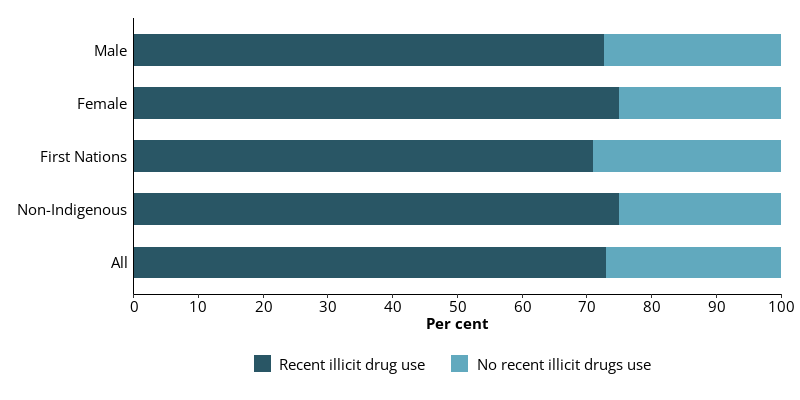
Notes
- Proportions are representative of this data collection only, and not the entire prison population.
- Excludes Victoria, which did not provide data for this item.
Source: Entrants form, 2022 NPHDC.
Prison entrants aged 25–34 were most likely to report using illicit drugs in the previous 12 months (82%) while those aged 45 and over were the least likely (56%) (Figure 9.11).
Figure 9.11: Prison entrants, illicit drug use in the previous 12 months, by age, 2022
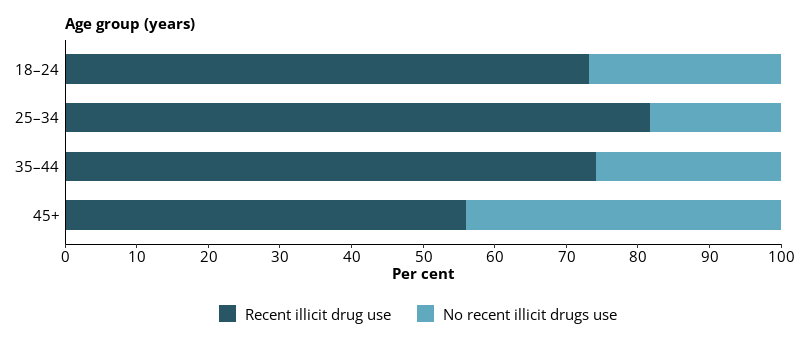
Notes
- Proportions are representative of this data collection only, and not the entire prison population
- Excludes Victoria, which did not provide data for this item.
Source: Entrants form, 2022 NPHDC.
The most commonly reported drug used by prison entrants for non-medical purposes – or that was not supplied to them medically – was cannabis, with more than a half (53%) reporting having used it at least once in the previous 12 months (Figure 9.12).
Methamphetamines/amphetamines were also commonly used with 46% of prison entrants reporting using them at least once in the previous 12 months.
Figure 9.12: Prison entrants, illicit drug use in the previous 12 months, by drug type, 2022
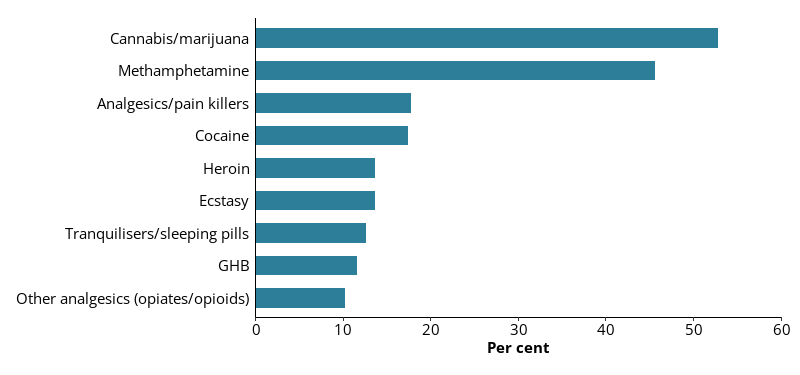
Notes
- Proportions are representative of this data collection only, and not the entire prison population.
- Excludes Victoria, which did not provide data for this item.
Source: Entrants form, 2022 NPHDC.
Younger prison entrants were more likely to report using illicit drugs in the past 12 months than older entrants. Recent use of methamphetamine before prison entry was lowest for those aged 18–24 (31%) and highest for those aged 25–34 (51%), before decreasing with age.
Recent cannabis use decreased across age groups, from 59% of those aged 18–24, to 45% of entrants aged 45 and over. Recent illicit use of methamphetamine, cocaine, analgesics, GHB, and heroin were most commonly reported by entrants aged 25–34 (Figure 9.13).
Figure 9.13: Prison entrants, illicit drug use in the previous 12 months, by age and drug type, 2022
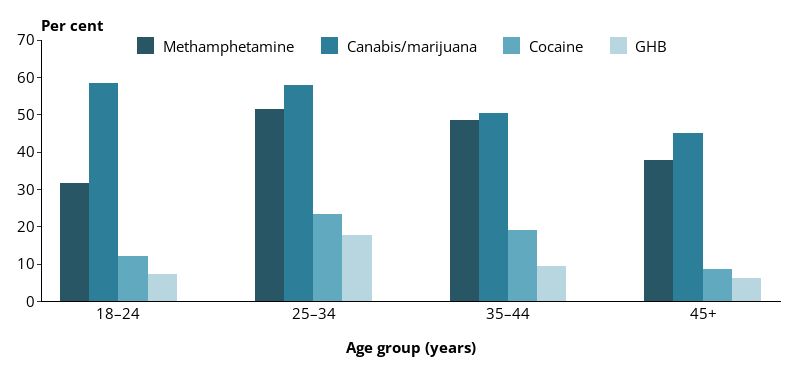
Notes
- Proportions are representative of this data collection only, and not the entire prison population.
- Excludes Victoria, which did not provide data for this item.
Source: Entrants form, 2022 NPHDC.
Illicit drug use among prison dischargees
Prison dischargees were asked if they had used illicit drugs before entering prison. Over a half (55%) of dischargees reported having done so.
Injecting drug use
Injecting drug use among prison entrants
Almost one-third (29%) of prison entrants reported they had injected drugs at some stage in their lives (Indicator 2.2.8).
Fewer than 1 in 5 (17%) prison entrants aged 18–24 reported they had injected drugs at some stage in their lives, while more than 1 in 3 (35%) prison entrants aged 35–44 reported having done so.
Of those prison entrants who reported injecting drugs at some stage in their lives, 38% reported they had injected drugs very often in the last 12 months, 17% reported they injected drugs often and 31% reported injecting drugs sometimes (Figure 9.14).
First Nations entrants (48%) reported injecting drugs very often in the last 12 months, with only 9.6% reporting never injecting in the same period. Nearly 1 in 3 (30%) non-Indigenous entrants reported injecting very often in the last 12 months, with nearly 1 in 5 (19%) reporting never injecting in the same period.
Figure 9.14: Prison entrants, frequency of injecting drug use in the previous 12 months, by sex and Indigenous identity, 2022
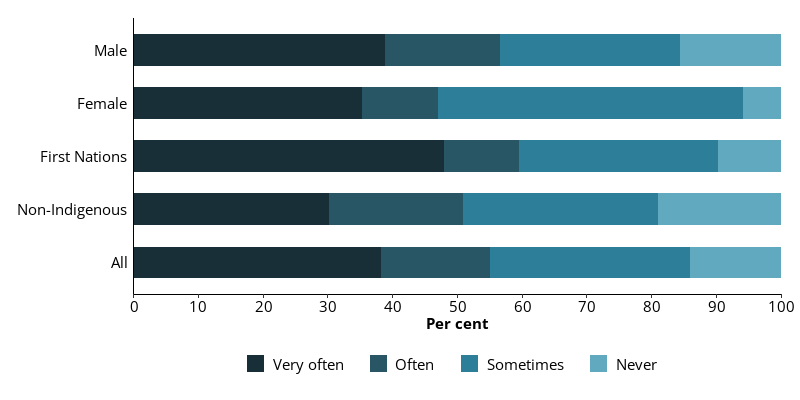
Notes
- Proportions are representative of this data collection only, and not the entire prison population.
- Proportions are representative of 107 prison entrants who reported ever injecting drugs.
- Excludes Victoria, which did not provide data for this item.
Source: Entrants form, 2022 NPHDC.
Illicit drug use comparisons with general community
People entering prison were more than 4 times as likely to report illicit drug use in the preceding 12 months as people in the general community (73% and 17%, respectively) (AIHW 2020).
In the general community, males (20%) were more likely than females (13%) to report illicit drug use in the previous 12 months (AIHW 2020). These differences were not observed in the prison population as males and females both had higher rates of illicit drug use in the previous 12 months (73% and 75%, respectively).
Males entering prison were almost 4 times as likely to report recent illicit drug use as males in the community, and females were almost 6 times as likely to do so as females in the community.
Prison entrants were consistently more likely to report recent illicit drug use than people of the same age in the general community.
Almost three-quarters (73%) of prison entrants aged 18–24 reported using illicit drugs in the previous 12 months, while about 1 in 3 (31%) people of the same age in the community reported doing so (AIHW 2020). Recent illicit drug use remained high among prison entrants aged 18–54, while in the community the proportions declined. About 3 in 5 (59%) prison entrants aged 45–54 reported using illicit drugs in the previous 12 months while 15% of people of the same age in the community reported doing so (Figure 9.15).
Cannabis was the most common illicit drug people in the community had recently used, at 12% (15% of males and 8.7% of females).
Male prison entrants were more than 3 times as likely as males in the community to report recent cannabis use, and female prison entrants were 6 times as likely as females in the community.
Prison entrants (46%) were more than 30 times as likely to report recent methamphetamine use as people in the community (1.4%) (AIHW 2020).
Figure 9.15: General community (2019) and prison entrants (2022), illicit drug use in the previous 12 months, by age
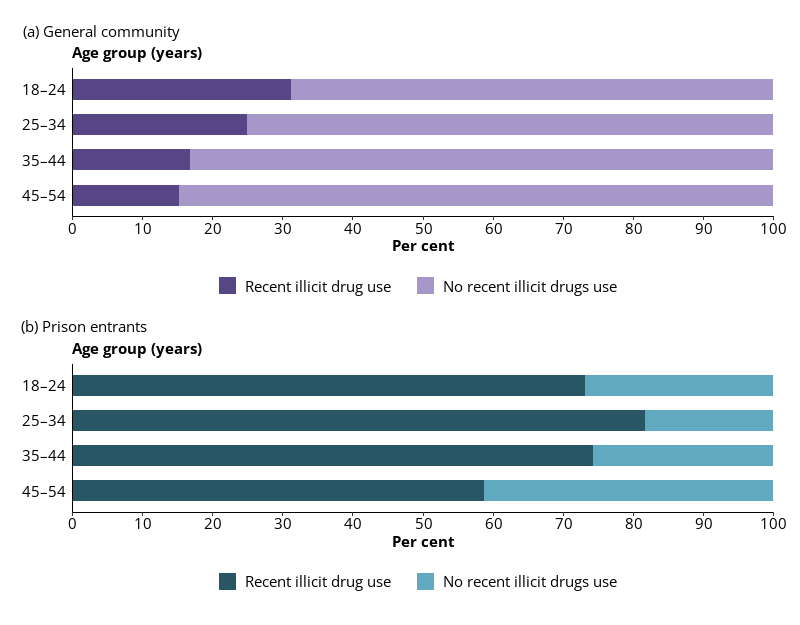
Notes
- Proportions of prison entrants are representative of this data collection only, and not the entire prison population.
- Prison entrants data excludes Victoria, which did not provide data for this item.
Sources: AIHW 2020; Entrants form, 2022 NPHDC.
Substance use in prison
There are fewer opportunities in prison to obtain and use illicit drugs than in the general community as prisons use multiple strategies to reduce the supply of illicit drugs, including drug detection dogs and urinalysis (Dolan and Rodas 2014). Compared with people in the community who can access sterile injecting equipment more readily, people in prison are at increased risk of contracting bloodborne viruses as a result of sharing injecting equipment, particularly hepatitis C (Cunningham et al. 2018).
Substance use among prison dischargees
Prison dischargees were asked whether they had used substances in prison, and whether they had injected substances in prison.
Almost 2 in 5 (37%) prison dischargees reported using illicit drugs in prison (Indicator 2.2.9).
Over a half (55%) of First Nations dischargees reported they had not used substances in prison while 41% had.
Of 231 non-Indigenous prison dischargees, 62% reported they had not used substances in prison while 35% had (Figure 9.16).
Figure 9.16: Prison dischargees, illicit drug use while in prison, by sex and Indigenous identity, 2022
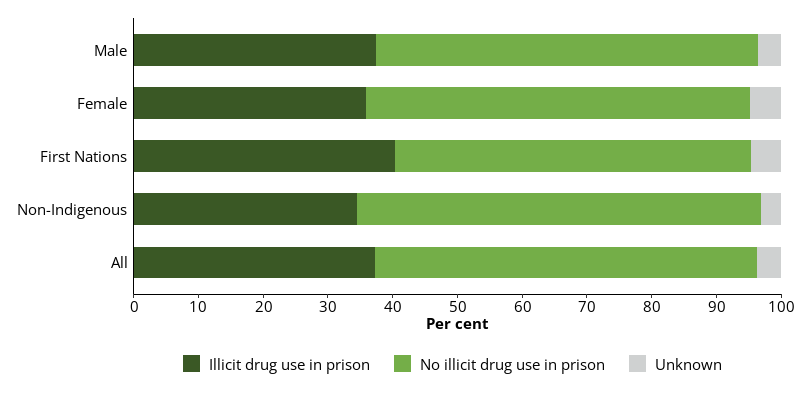
Notes
- Proportions of prison entrants are proportions in this data collection only, and not the entire prison population.
- Excludes Victoria, which did not provide data for this item.
Source: Dischargees form, 2022 NPHDC.
Prison dischargees aged 25–34 (40%) were the group most likely – and dischargees aged 45 and over (32%) the least likely – to report using substances for non-medical purposes, or that were not supplied to them medically while in prison.
Injecting substances among prison dischargees
About 1 in 7 (14%) prison dischargees reported injecting substances in prison (Indicator 2.2.10).
Prison dischargees were asked if they had injected substances during their current time in prison.
About 1 in 7 (15%) male dischargees and about 1 in 20 (6.2%) female dischargees reported injecting substances in prison.
Dischargees aged 18–24 were the group most likely to inject substances in prison (18%) while those aged 45 and over were the least likely (8.3%).
More than 4 in 5 First Nations dischargees (82%) reported not injecting substances while in prison while about 1 in 6 (16%) reported injecting substances in prison.
Almost 9 in 10 non-Indigenous dischargees (87%) reported never injecting substances in prison while about 1 in 10 (12%) reported injecting substances in prison.
AIHW (Australian Institute of Health and Welfare) (2020) National Drug Strategy Household Survey 2019, AIHW website, accessed 24 April 2023, doi:10.25816/e42p-a447.
Cunningham EB, Hajarizadeh B, Amin J, Bretana N, Dore GJ, Degenhardt L, Larney S, Luciani F, Lloyd AR and Grebely J (2018) ‘Longitudinal injecting risk behaviours among people with a history of injecting drug use in an Australian prison setting: the HITS-p study’, International Journal of Drug Policy, 54:18–25.
Darke S, Kaye S and Duflou J (2017) ‘Rates, characteristics and circumstances of methamphetamine-related death in Australia: a national 7-year study’, Addiction,
112:2191–2201.
Dolan K and Rodas A (2014) ‘Detection of drugs in Australian prisons: supply reduction strategies’, International Journal of Prison Health, 10:111–117.
Forsyth SJ, Carroll M, Lennox N and Kinner SA (2018) ‘Incidence and risk factors for mortality after release from prison in Australia: a prospective cohort study’, Addiction, 113(5):937–945, doi:10.1111/add.14106.
Goldsmid S and Willis M (2016) ‘Methamphetamine use and acquisitive crime: evidence of a relationship’, Trends & Issues in Crime and Criminal justice, number 516, Australian Institute of Criminology, Canberra.
Goodwin LRJ and Sias SM (2014) ‘Severe substance use disorder viewed as a chronic condition and disability’, Journal of Rehabilitation 80:42–49.
Kopak AM and Hoffmann NG (2014) ‘Pathways between substance use, dependence, offense type, and offense severity’, Criminal Justice Policy Review 25:743–760.
Marel C, Mills KL, Darke S, Ross J, Slade T, Burns L et al. (2013) ‘Static and dynamic predictors of criminal involvement among people with heroin dependence: findings from a 3- year longitudinal study’, Drug and Alcohol Dependence 133:600–606.
Tait RJ, Whetton S, Shanahan M, Cartwright K, Ferrante A, Gray D, Kaye S, McKetin R, Pidd K, Ritter A, Roche A and Allsop S (2018) ‘Quantifying the societal cost of methamphetamine use to Australia’, International Journal of Drug Policy, 62:30–36.


